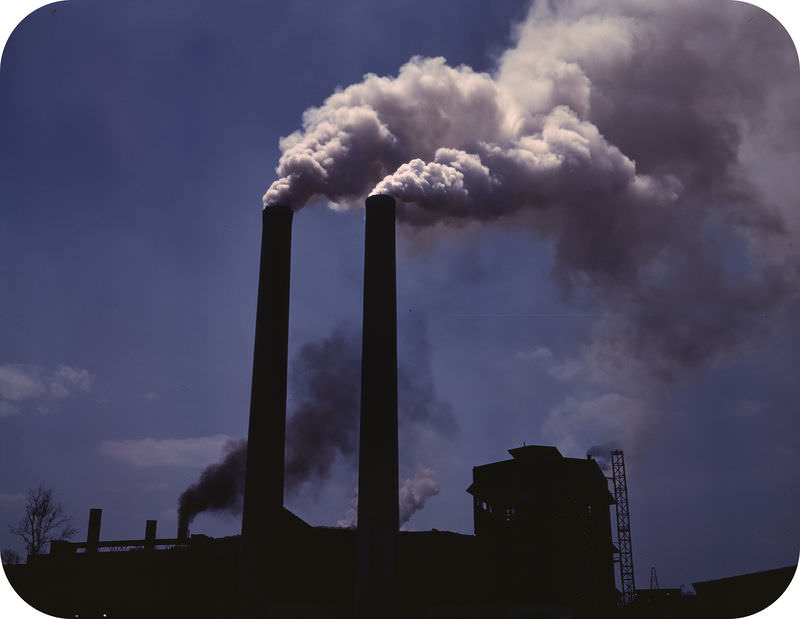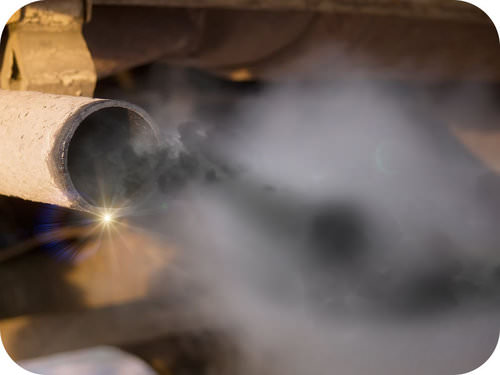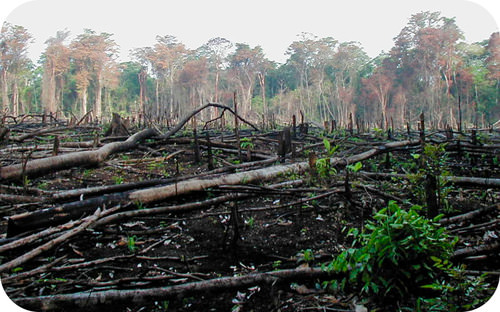10.21空气污染的原因
章节大纲
-
Why don't we see emissions like this too often any more?
::为什么我们不再经常看到这种排放呢?This photo of a power plant was taken before emission control equipment was added. Emissions are down since laws have been enacted to protect the air.
::这张照片是发电厂在添加排放控制设备之前拍摄的,自颁布保护空气的法律以来,排放量下降。Causes of Air Pollution
::造成空气污染的原因Most air pollutants come from burning fossil fuels or plant material. Some are the result of evaporation from human-made materials. Nearly half (49%) of air pollution comes from transportation, 28% from factories and power plants, and the remaining pollution from a variety of other sources.
::大多数空气污染物来自燃烧化石燃料或植物材料,有些是人为材料蒸发的结果,将近一半(49%)的空气污染物来自运输,28%来自工厂和发电厂,其余污染物来自其他各种来源。Fossil Fuels
::化石燃料Fossil fuels are burned in most motor vehicles and power plants. These non-renewable resources are the power for nearly all manufacturing and other industries. Pure coal and petroleum can burn cleanly and emit only carbon dioxide and water , but most of the time these fossil fuels do not burn completely and the incomplete chemical reactions produce pollutants. Few sources of these fossil fuels are pure, so other pollutants are usually released. These pollutants include carbon monoxide, nitrogen dioxide, sulfur dioxide, and hydrocarbons .
::大多数机动车辆和发电厂燃烧化石燃料,这些不可再生资源是几乎所有制造业和其他工业的动力。 纯煤炭和石油可以清洁地燃烧,只能排放二氧化碳和水,但大部分时间这些化石燃料不能完全燃烧,化学反应不完全会产生污染物。 这些化石燃料的源头很少是纯净的,因此其他污染物通常会释放。这些污染物包括一氧化碳、二氧化氮、二氧化硫和碳氢化合物。In large car-dependent cities such as Los Angeles and Mexico City, 80% to 85% of air pollution is from motor vehicles ( Figure ). Ozone , carbon monoxide, and nitrous oxides come from vehicle exhaust.
::在洛杉矶和墨西哥城等大型依赖汽车的城市,80%至85%的空气污染来自机动车辆(图......),臭氧、一氧化碳和一氧化二氮来自车辆排气。Auto exhaust like this means that the fuels is not burning efficiently.
::这样自动排气意味着燃料燃烧效率不高。A few pollutants come primarily from power plants or industrial plants that burn coal or oil . Sulfur dioxide (SO 2 ) is a major component of industrial air pollution that is released whenever coal and petroleum are burned. SO 2 mixes with H 2 O in the air to produce sulfuric acid (H 2 SO 4 ).
::一些污染物主要来自燃烧煤炭或石油的发电厂或工厂,二氧化硫(SO2)是工业空气污染的主要成分,当煤炭和石油燃烧时释放出来,二氧化硫与空气中的H2O混合产生硫酸(H2SO4)。Mercury is released when coal and some types of wastes are burned. Mercury is emitted as a gas, but as it cools, it becomes a droplet. Mercury droplets eventually fall to the ground. If they fall into sediments , bacteria convert them to the most dangerous form of mercury: methyl mercury. Highly toxic, methyl mercury is one of the metal’s organic forms.
::汞在燃煤和某些类型的废物燃烧时会释放出来。汞作为气体排放,但随着冷却,它会变成一个小滴。 汞滴最终会落到地上。 如果它们落到沉积物中,细菌会把它们转化成最危险的汞形式:甲基汞。 甲基汞是高毒性的,是金属的有机形式之一。Biomass Burning
::生物质燃烧Fossil fuels are ancient plants and animals that have been converted into usable hydrocarbons. Burning plant and animal material directly also produces pollutants. Biomass is the total amount of living material found in an environment. The biomass of a rainforest is the amount of living material found in that rainforest.
::化石燃料是古代植物和动物,已经转化为可使用的碳氢化合物,燃烧植物和动物材料也直接产生污染物,生物物质是在环境中发现的活物质总量,雨林的生物量是该雨林中发现的活物质数量。The primary way biomass is burned is for slash-and-burn agriculture ( Figure ). The rainforest is slashed down and then the waste is burned to clear the land for farming. Biomass from other biomes , such as the savannah, is also burned to clear farmland. The pollutants are much the same as from burning fossil fuels: CO 2 , carbon monoxide, methane, particulates , nitrous oxide, hydrocarbons, and organic and elemental carbon. Burning forests increases greenhouse gases in the atmosphere by releasing the CO 2 stored in the biomass and also by removing the forest so that it cannot store CO 2 in the future. As with all forms of air pollution, the smoke from biomass burning often spreads far and pollutants can plague neighboring states or countries.
::燃烧生物物质的主要方式是刀耕火种的农业(图 ) 。雨林被砍倒,然后焚烧废物以清除耕地。其他生物群(如热带草原)的生物量也被烧掉以清除农田。污染物与燃烧化石燃料的污染物基本相同:二氧化碳、一氧化碳、甲烷、颗粒、一氧化二氮、碳氢化合物、有机碳和元素碳。燃烧森林释放生物群中储存的二氧化碳,并去除森林,使其今后无法储存二氧化碳,从而增加大气中的温室气体。同所有形式的空气污染一样,燃烧生物量的烟雾往往蔓延到很远的地方,污染会波及邻国。A forest that has been slash-and-burned to make new farmland.
::森林被砍伐和烧毁 以创造新的农田Particulates result when anything is burned. About 40% of the particulates that enter the atmosphere above the United States are from industry and about 17% are from vehicles. Particulates also occur naturally from volcanic eruptions or windblown dust. Like other pollutants, they travel all around the world on atmospheric currents.
::当任何物体被燃烧时,都会产生隔热。进入美国上空大气层的微粒约有40%来自工业,17%来自车辆,火山爆发或风尘也自然产生隔热。与其他污染物一样,这些微粒通过大气流环绕世界各地。Evaporation
::蒸发Volatile organic compounds (VOCs) enter the atmosphere by evaporation. VOCs evaporate from human-made substances, such as paint thinners, dry cleaning solvents, petroleum, wood preservatives, and other liquids. Naturally occurring VOCs evaporate off of pine and citrus trees. The atmosphere contains tens of thousands of different VOCs, nearly 100 of which are monitored. The most common is methane, a greenhouse gas ( Figure ). Methane occurs naturally, but human agriculture is increasing the amount of methane in the atmosphere.
::挥发性有机化合物(VOCs)通过蒸发进入大气层。挥发性有机化合物(VOCs)从油漆稀薄剂、干洗溶剂、石油、木材防腐剂和其他液体等人造物质中蒸发。自然产生的VOCs从松树和柑橘树上蒸发。大气中含有数万种不同的VOCs,其中近100种受到监测。最常见的是甲烷,一种温室气体(Figure )。甲烷自然产生,但人类农业正在增加大气中甲烷的数量。Methane forms when organic material decomposes in an oxygen-poor environment. In the top image, surface methane production is shown. Stratospheric methane concentrations in the bottom image show that methane is carried up into the stratosphere by the upward flow of air in the tropics.
::当有机材料在缺氧环境中分解时,甲烷就形成甲烷。在顶层图像中,表层甲烷的生产被显示。底部图像中平流层甲烷浓度显示,由于热带空气的上升,甲烷被带入平流层。Summary
::摘要- Most fossil fuels are dirty and release pollutants such as carbon monoxide, nitrogen dioxide, sulfur dioxide, and hydrocarbons.
::大多数化石燃料是肮脏的,排放污染物,如一氧化碳、二氧化氮、二氧化硫和碳氢化合物。
- Burning plants and other biomass releases pollutants including carbon monoxide, methane, particulates, nitrous oxide, hydrocarbons, and organic and elemental carbon.
::燃烧植物和其他生物量释放污染物,包括一氧化碳、甲烷、微粒、一氧化二氮、碳氢化合物、有机碳和元素碳。
- Volatile organic compounds evaporate into the air and become pollutants.
::挥发性有机化合物蒸发到空气中,成为污染物。
Review
::回顾- What is slash-and-burn agriculture and what pollutants does it release?
::什么是刀耕火种的农业,它释放了哪些污染物?
- What are volatile organic compounds and why are they pollutants?
::什么是挥发性有机化合物,为什么是污染物?
- Name a compound that occurs in the atmosphere naturally but is a pollutant in excess amounts due to human activities.
::说明在大气中自然出现的化合物,但是一种由于人类活动造成的超量污染物。
- Most fossil fuels are dirty and release pollutants such as carbon monoxide, nitrogen dioxide, sulfur dioxide, and hydrocarbons.



